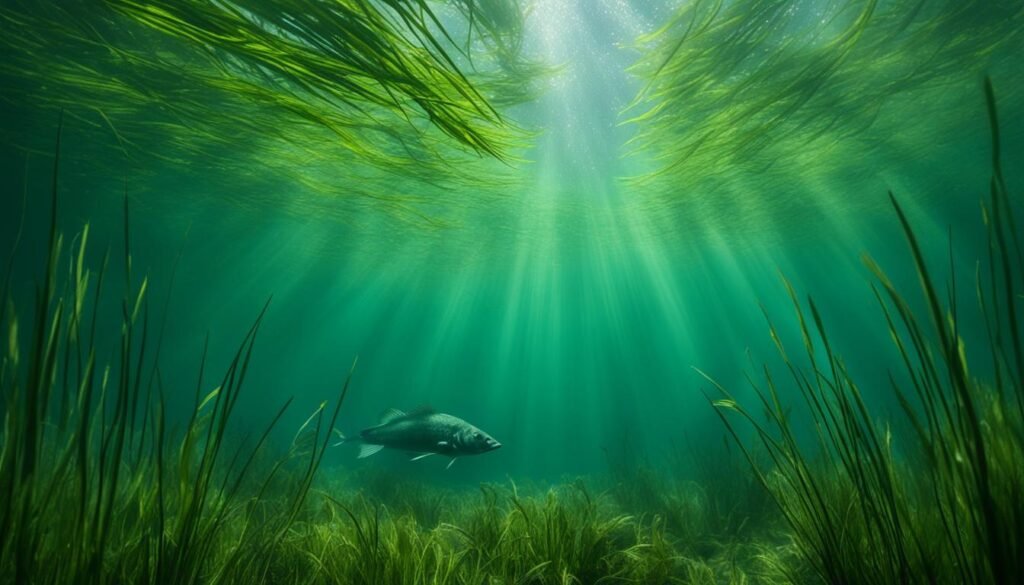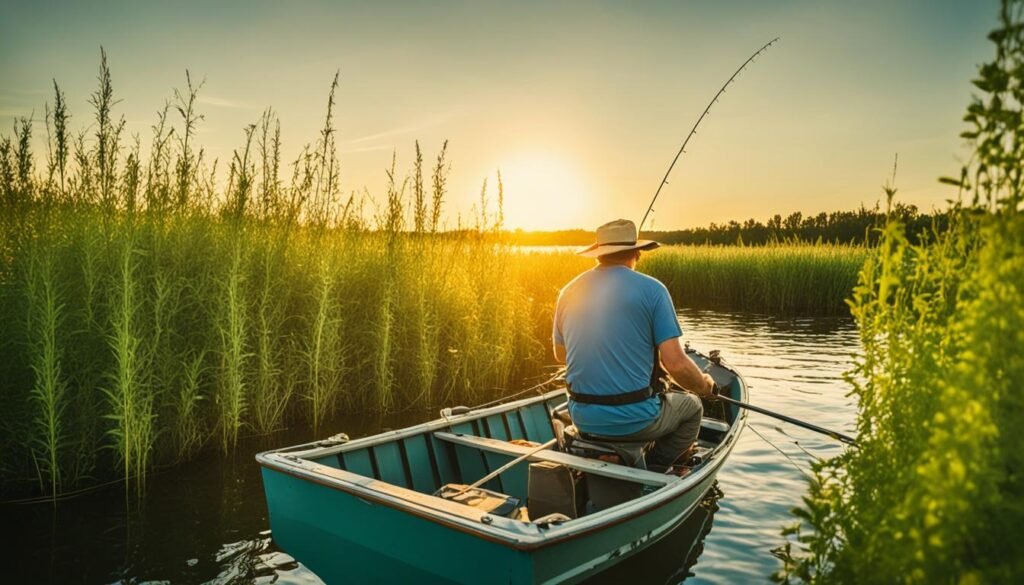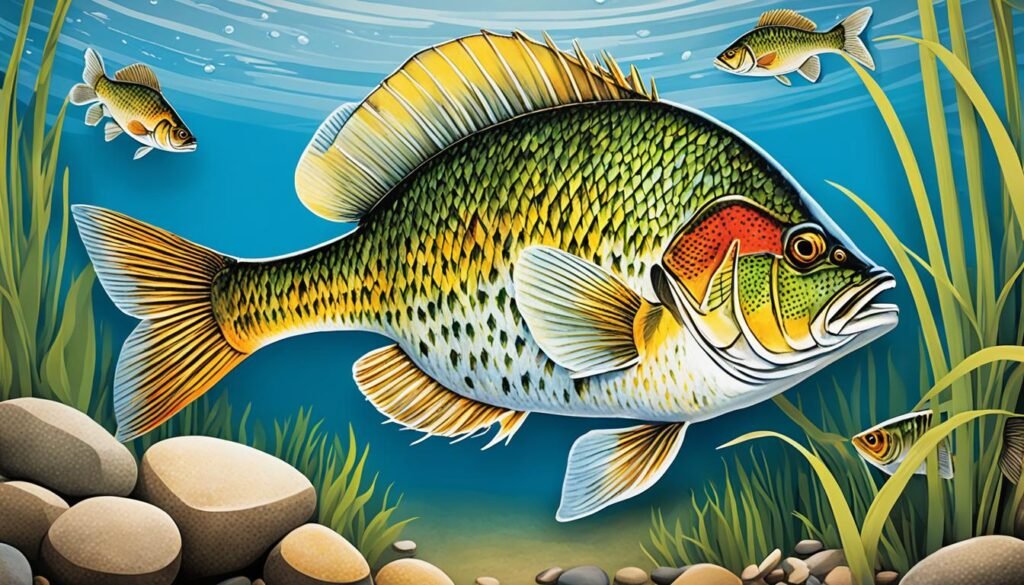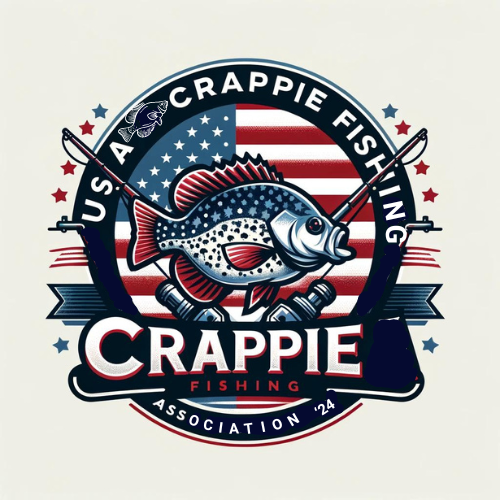“The charm of fishing is that it is the pursuit of what is elusive but attainable, a perpetual series of occasions for hope.” – John Buchan
Welcome to a world where kayak fishing becomes more than just a hobby. It becomes an edge, a strategy, a way of domination. In the realm of stealth kayak fishing, success lies in the perfect combination of technique, access, and tactics. Whether you’re a beginner venturing into the world of kayak fishing or an experienced angler looking to up your game, this article is here to reveal the secrets of successful kayak fishing.
Key Takeaways:
- Discover the accessible kayak fishing tactics that can give you an edge on the water.
- Unleash advanced kayak fishing techniques that will enhance your chances of landing big catches.
- Explore stealth kayak fishing strategies that will make you a master of the art.
- Learn successful kayak fishing tips from seasoned anglers who have honed their skills.
- Embrace the thrill of kayak fishing and experience the joy of pursuing what is both elusive and attainable.
The Challenge of Pursuing Trophy Largemouth Bass
Pursuing trophy largemouth bass is a challenging endeavor that requires skill and knowledge. These fish are more advanced and elusive than their smallmouth counterparts. Understanding their patterns and habits is crucial for success. Patterns may vary based on location, weather, and other factors. Adaptation is key as patterns can change unexpectedly. Small fish are usually easier to catch than trophies and will not be discussed in this article.
When targeting trophy largemouth bass, anglers must be prepared for a challenging pursuit. These fish have earned their reputation as elusive creatures, requiring a strategic approach to catch.
To successfully pursue mega largemouths, understanding their distinct patterns is essential. Each body of water has its own largemouth bass population, with unique habits and behaviors.
The pursuit of trophy largemouth bass can be likened to solving a complex puzzle. Anglers must analyze the puzzle pieces, deciphering the patterns that lead to success. These patterns can be affected by a multitude of factors, including location, weather, and time of year.
Mastering the art of trophy largemouth bass fishing is truly a test of skill and determination. It requires unwavering dedication, adaptability, and a deep understanding of their behaviors. The pursuit may be challenging, but the reward of landing a trophy largemouth bass is unparalleled.
While smallmouth bass may be more straightforward to catch, largemouth bass present a more challenging pursuit. Their advanced nature and elusive tendencies demand a higher level of expertise from anglers.
It is important to note that in this article, we will focus exclusively on pursuing trophy largemouth bass. Small fish, although enjoyable to catch, will not be the subject of our discussion.
Understanding Largemouth Patterns
Largemouth bass are known for their ability to adapt to their surroundings, making them a formidable opponent for anglers. Being able to read and understand their patterns is crucial for success on the water.
Largemouth bass patterns can vary based on several factors, including:
- Location: Different bodies of water have unique patterns specific to their ecosystem.
- Weather: Changes in weather conditions can impact the behavior and activity of largemouth bass.
- Time of Year: Largemouth bass exhibit different patterns during different seasons, such as spawning or feeding patterns.
Adaptation is key when pursuing trophy largemouth bass. As patterns can change unexpectedly, anglers must remain flexible and adjust their strategies accordingly.
While the pursuit of trophy largemouth bass may be challenging, it is undoubtedly a rewarding and fulfilling endeavor. Stay tuned as we delve further into the tactics and strategies for successfully targeting largemouth bass in our upcoming sections.
Targeting Largemouth Bass in Green Water and Eutrophic Lakes
Largemouth bass are known for thriving in warm, shallow waters with abundant vegetation. Green water and eutrophic lakes, which are nutrient-rich and often heavily vegetated, provide the perfect habitat for these prized game fish. These lakes support a diverse range of plant species, including lilies, pond-weeds, and milfoil, creating an ideal environment for largemouth bass to flourish.
Anglers seeking to target largemouths in green water and eutrophic lakes should focus on specific areas that maximize their chances of success. Shallow emergent cover, such as overhanging branches, fallen trees, and dense grasses, are prime locations where largemouth bass seek refuge and ambushing opportunities. These areas offer excellent concealment and ample feeding opportunities for largemouths.
In deeper sections of green water and eutrophic lakes, anglers can also find submergent weed growth, which provides additional cover for largemouth bass and attracts prey. Fishing in these areas requires adapting techniques to the unique conditions. Using jigs, creature baits, Tokyo rigs, or punch rigs can be effective in enticing largemouths lurking in the depths among the submergent weeds.

Of course, understanding the behavior and preferences of largemouth bass in these environments is crucial. Largemouths are likely to be most active during periods of algal bloom conditions, as the increased nutrients and resulting food chain fluctuations create optimal feeding opportunities. Anglers should pay attention to water temperature, weather patterns, and other natural cues to identify the prime times for targeting largemouth bass in green water and eutrophic lakes.
To summarize, targeting largemouth bass in green water and eutrophic lakes requires a strategic approach. By focusing on shallow emergent cover and areas with submergent weed growth, anglers can increase their chances of hooking into these prized game fish. Adapting techniques such as using jigs, creature baits, Tokyo rigs, or punch rigs can yield substantial results. Remember to stay observant of the surrounding conditions and adjust your strategy accordingly for a successful fishing experience.
Maximizing Success with Perfect Plants
Aquatic plants are vital to the habitat and feeding patterns of largemouth bass. These underwater ecosystems depend on native plant species, such as bulrushes, lily pads, coontail, and northern milfoil, to thrive. Among these plants, green cabbage stands out as a favorite among largemouth bass. Its deep-growing nature makes it particularly enticing to these fish. When targeting largemouth bass, fishing the edges and outside edges of these plant beds can be highly productive. This strategic approach capitalizes on baitfish congregations and provides ample feeding opportunities for largemouth bass.

The Importance of Bluegill Connections
When it comes to successful largemouth fishing, understanding the importance of bluegills is essential. Bluegills serve as a vital food source for largemouth bass, and knowing their behavior can greatly enhance your chances of landing a trophy catch.
One key indicator of bluegill activity is the presence of bluegill schools. These schools often indicate active feeding and can attract largemouth bass to the area. Keep an eye out for surface explosions and other signs of surface activity, as these are clear indications that largemouths may be feeding on bluegills in the vicinity.
To effectively target largemouth bass during the summer months, it’s crucial to utilize bluegill-imitation patterns. These patterns mimic the appearance and movement of bluegills, making them irresistible to hungry largemouths. Consider using lures or flies that resemble bluegills, such as crankbaits, swimbaits, or soft plastic baits in bluegill color schemes.
Observing the surface for bluegill activity can lead me straight to the hottest spots for summer largemouth fishing. By using bluegill-imitation patterns, I increase my chances of triggering a strike from a feeding largemouth bass.
By establishing a connection with bluegills and honing in on their feeding habits, you can greatly increase your success in largemouth bass fisheries. Pay attention to surface activity, employ bluegill-imitation patterns, and get ready to reel in your next trophy catch!

Unleashing the Power of Shallow Edges
Largemouth bass can often be found in shallow cover close to shore, particularly in the early morning and late evening. These areas provide protective cover and attract baitfish. By targeting these shallow edges and using techniques like vertical presentations, swim jigs, wacky rigs, and crankbaits, anglers can increase their chances of landing quality largemouth bass. It is important to approach these areas with light tackle and make accurate casts to maximize success.
Maximizing Success with Shallow Edges
To fully unlock the potential of fishing in shallow edges, anglers need to understand the advantages these areas offer. Shallow edges provide protective cover for largemouth bass, allowing them to hide and ambush prey. Additionally, these areas are often close in range to shore, making them easily accessible from a kayak or small boat. The presence of submerged rocks within shallow edges acts as an attractant for baitfish, drawing in hungry bass.
When targeting shallow edges, using light tackle is essential. Lighter rods, reels, and lines allow for more accurate casts and better sensitivity to detect bites. It’s recommended to use a medium to medium-light spinning rod and reel combo with six to ten-pound test line. This setup provides the necessary finesse and control required for fishing in this environment.
Effective Techniques and Presentations
Various techniques can be effective when fishing shallow edges. Vertical presentations such as drop-shotting or pitching soft plastics directly into target areas can entice largemouth bass hiding in the cover. This approach allows for precise bait placement and mimics natural movement.
Another effective technique is using swim jigs. These lures can be retrieved smoothly through the shallows, imitating baitfish and triggering reaction strikes. The combination of a weedless hook and a swimming action skirt makes swim jigs ideal for navigating vegetated areas.
Wacky rigs are also a go-to choice for fishing shallow edges. This technique involves hooking a soft plastic bait, such as a Senko worm or stick bait, in the middle and allowing it to fall naturally near cover. The wacky rig’s erratic action and slow descent can be irresistible to hungry bass.
Lastly, crankbaits can be effective when targeting shallow edges with submerged rocks. The diving action of crankbaits allows them to explore different depths, while the rattling sound and realistic appearance mimic forage that bass are actively seeking. Opt for shallow-diving crankbaits that will run just above the submerged rocks, reducing the risk of getting snagged.
Recommended Lures for Fishing Shallow Edges
| Technique | Lure Type | Key Features |
|---|---|---|
| Vertical Presentations | Soft Plastics (e.g., worms, craws) | Weedless, natural colors |
| Swim Jigs | Jigs with swimming action skirts | Weedless, realistic color patterns |
| Wacky Rigs | Soft Plastics (e.g., Senko worms, stick baits) | Flexible, slow sink rate |
| Crankbaits | Shallow-diving crankbaits | Rattling sound, realistic appearance |
By incorporating these techniques into your fishing repertoire and targeting shallow edges with precision, you can unlock the potential for landing quality largemouth bass. Remember to adapt your technique and lure selection based on the prevailing conditions and adjust your approach as needed. With a combination of skillful execution, light tackle, and strategic presentations, you can increase your chances of hooking into a trophy-sized largemouth bass.

Bait Selection for Tautog Fishing
Selecting the right bait is crucial for tautog fishing. In early fall, tautog often forage in shallow waters, making bait selection a critical factor in attracting them. Let’s explore some of the top bait options for targeting these elusive fish.
Asian Shore Crabs
Asian shore crabs are small crab species that closely resemble the natural prey of tautog. Their small size and agile movements make them a stealthy presentation for enticing tautog to bite. Pairing Asian shore crabs with tog jigs can enhance their effectiveness, as the jigs provide added movement and mimic the natural behavior of these crabs.
Green Crabs
Along the Northeast coast, green crabs are a popular and readily available bait option for tautog fishing. These crabs are known for their oily and smelly nature, which makes them highly attractive to tautog. Green crabs can be easily hooked and presented to mimic natural crab movements, making them a reliable choice for enticing tautog to feed.
White Leggers: The Secret Weapon
While rare to find and more difficult to obtain, white leggers are considered the secret weapon in tautog fishing. These large, meaty crabs are highly effective in catching larger tautog due to their size and presentation. When targeting bigger fish, using white leggers as bait can significantly increase your chances of success. Ensure you have these elusive crabs in your arsenal if you’re on the hunt for trophy tautog.
When presenting bait, it’s crucial to consider the fishing environment. Tautog are commonly found near shallow water rock piles, where they seek shelter and food. Using the right bait, such as Asian shore crabs, green crabs, or white leggers, in these areas can greatly improve your chances of enticing tautog to bite.
The Best Bait for Tautog Fishing: A Comparison
| Bait Type | Description | Availability | Effectiveness |
|---|---|---|---|
| Asian Shore Crabs | Small crab species resembling natural prey | Moderate | Effective with tog jigs for a stealthy presentation |
| Green Crabs | Oily and smelly crabs readily available along Northeast coast | High | Attracts tautog with their scent and movement |
| White Leggers | Rare and larger crabs, excellent for targeting trophy tautog | Low | Proven highly effective for catching larger fish |
When considering bait selection for tautog fishing, it’s crucial to choose options that closely resemble their natural prey and appeal to their feeding instincts. Asian shore crabs, green crabs, and white leggers offer different benefits and can be used strategically based on your fishing goals and availability. Experimenting with different bait options and techniques will help you refine your approach and increase your chances of a tautog-filled day on the water.
Rigs vs. Jigs: Tautog Fishing Techniques
When it comes to tautog fishing, anglers have the option of using rigs or jigs to target these hard-fighting fish. Each technique has its advantages and can be effective, depending on the conditions and preferences of the angler.
Rigging for Success
Rigging involves setting up a fishing rig with multiple hooks to present bait to tautog. Two popular rig options for tautog fishing are the slider rig and the V-Rig.
The slider rig consists of a sliding sinker above the hooks, which allows the bait to move more naturally with the current. This rig can increase the chances of hooking up with a tautog, as the bait is presented in a more enticing manner.
The V-Rig is another effective rigging option for tautog. It features two hooks positioned in a V shape, with the top hook serving as a weed guard to reduce snagging while fishing in rocky areas. The V-Rig allows for a secure hook-set when a tautog grabs the bait.
| Pros of Rigging | Cons of Rigging |
|---|---|
| Effective presentation of bait | Can be more time-consuming to set up |
| Increased hook-up rate | Requires careful attention to leader-to-braid knots |
| Allows for fishing with multiple hooks | May require more gear and tackle |
The Art of Jigging
Jigging has gained popularity among tautog anglers due to its ability to produce both quantity and quality catches. This technique involves using a specially designed jig that mimics the movement of a crab or other tautog prey.
To effectively jig for tautog, it’s important to have the right setup. A reel with a high-end drag system, braided line, and a light tip rod are essential for detecting subtle strikes and successfully battling these strong fish.
Presentation is key when jigging for tautog. Anglers should pay attention to the size and color of the jig, as this can make a difference in attracting the attention of these finicky fish. Experimenting with different jig sizes and colors can help determine what works best on a particular day or in specific fishing conditions.
| Pros of Jigging | Cons of Jigging |
|---|---|
| Can produce both quantity and quality catches | Requires skill and practice to master |
| Offers a more active and engaging fishing experience | May require investment in specialized jigging gear |
| Allows for precise and targeted presentations | Requires understanding of tautog behavior and feeding patterns |
Whether choosing to rig or jig, tautog fishing techniques require attention to detail and the right bait presentation. In both cases, using the correct size and color of crabs as bait is crucial for enticing tautog to bite. By honing these techniques and adapting to the conditions, anglers can increase their chances of success when targeting these challenging fish.
The Importance of Bait in Tautog Fishing
When it comes to tautog fishing, one of the key factors for success is bait selection. Choosing the right bait can make a significant difference in catching these elusive fish. Factors such as water depth, temperature, and fishing pressure are important variables to consider when selecting bait for tautog.
Asian shore crabs, green crabs, and white leggers are popular bait options for tautog. Each bait has its own advantages and can be effective in specific situations. Understanding when and where to use each bait is essential for maximizing your chances of success.
Asian shore crabs are stealthy and can make for a great presentation. They are especially effective in shallow waters during the early fall. Green crabs, on the other hand, are a popular choice along the Northeast coast. Their oily and smelly nature attracts tautog and provides an enticing meal. Lastly, white leggers are a secret weapon when it comes to targeting larger tautog. Although rare and more difficult to obtain, white leggers have proven to be highly effective.
By considering the variables of anchoring, water depth, water temperature, and fishing pressure, you can make an informed decision on which bait to use. Experimentation and adapting your bait selection strategy based on the behavior of tautog can greatly improve your chances of a successful fishing trip.
Factors to Consider for Bait Selection:
- Water Depth: The depth at which you are fishing can impact the bait choice. Tautog in shallow waters may be more responsive to Asian shore crabs, while those in deeper waters may prefer green crabs.
- Water Temperature: Tautog have different feeding patterns based on water temperature. Adjust your bait selection accordingly to match their preferences.
- Fishing Pressure: The level of fishing pressure in the area can influence the effectiveness of certain baits. Understanding the local fishing pressure can help you choose bait that stands out.
Bait Options for Tautog Fishing:
“Choosing the right bait for tautog is like finding the perfect key to unlock their feeding instincts.” – Experienced Angler
| Bait Option | Use Cases |
|---|---|
| Asian Shore Crabs | Shallow waters, early fall |
| Green Crabs | Popular choice along the Northeast coast |
| White Leggers | Targeting larger tautog |
By carefully selecting the right bait based on the variables at play, you can significantly increase your chances of hooking tautog. Remember to pay attention to the conditions and behavior of tautog to make informed bait choices. Good bait selection is key to a successful tautog fishing trip.
Mastering Tautog Rigs and Jigging Techniques
When it comes to tautog fishing, mastering rigs and jigging techniques is crucial for success. The right presentation can make all the difference in enticing these crafty fish to bite. Let’s explore some effective strategies for rigging and jigging that will help you maximize your catch.
Using Two-Hook Rigs for Effective Presentations
One popular rig for tautog fishing is the slider rig. This rig allows you to present bait in a natural and enticing manner. By attaching two hooks, you increase your chances of hooking a tautog. The V-Rig is another effective two-hook rig that provides a realistic presentation, mimicking the movement of crabs, which are a favorite food of tautog.
Paying Attention to Leader-to-Braid Knots
Strong and secure connections are essential when rigging for tautog. Make sure to pay attention to the leader-to-braid knot to ensure it is properly tied for maximum strength. A reliable knot will prevent break-offs and increase your chances of landing these hard-fighting fish.
Selecting the Right Size and Color Jigs
Jigging is a popular technique for targeting tautog. Choosing the right size and color jig is key to enticing strikes. Tautog tend to prefer smaller jigs, so opt for sizes between 3/4 and 2 ounces. As for colors, dark color jigs, such as black, purple, or dark green, often prove successful. Experimenting with different colors and sizes can help you determine what works best in your fishing area.
Understanding Tautog Behavior and Water Conditions
Tautog can be selective feeders, especially in areas with heavy fishing pressure. Understanding their behavior and the conditions they prefer will give you an advantage. Pay attention to water depth, temperature, and clarity. Tautog are often found near rocky structures, wrecks, or jetties, so focus your efforts in these areas for better results. Adjust your setup and presentation based on the current conditions to increase your chances of success.
By mastering tautog rigs and jigging techniques, you’ll be well-equipped to tackle these challenging fish. Remember to experiment with different rigs, pay attention to leader-to-braid knots, and adapt your presentation to the behavior of tautog. With practice and persistence, you’ll improve your skills and have more success on the water.
Conclusion
Overall, successful kayak fishing and tautog fishing require a combination of skill, knowledge, and attention to detail. Anglers who understand largemouth bass patterns and select the right bait for tautog can significantly improve their chances of success.
By implementing these tactics and strategies, kayak anglers can enhance their stealth, access, and overall fishing experience. It is important to remain adaptable to changing conditions and continually experiment with different techniques to continuously improve your fishing game.
Remember, kayak fishing and tautog fishing are not just about the catch, but also about the enjoyment and connection to nature. So, get out on the water, explore new fishing spots, and have fun while honing your fishing skills. By combining knowledge, perseverance, and a love for the sport, you can become a successful and well-rounded angler.
